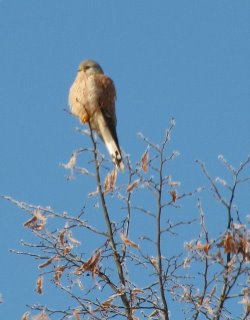Kestrel Pictures
Earlier, I said that it was almost impossible to take an image of a kestrel -- even though I saw so many of them in England.
In the end, I had to wait until I reached Germany, before I managed to take a couple of good photos. Here's one of the better ones.

And here's one of my favourites -- with the kestrel just entering flight. This was actually a setup photo. This kestrel sat in one of three trees for about 5 hours (we saw it earlier in the morning, and when we came back in the evening, it was still there). Throughout that time, it kept flying from tree to tree.
I tried for about half and hour to get a natural picture of it -- but by the time I had inched close to it on one tree --- it would fly to the next tree.
I realized that from Tree A, the kestrel would always fly to Tree B -- so, when he took off from Tree A, I focused on Tree B.
Well -- for the one and only time -- the bird flew to Tree C, bypassing Tree B.
I began to think that that bird had it in for me.
Well, finally, when the bird sat down at one of the trees, I focused on it -- and then got my mum to yell and spook the kestrel -- startled, it started to fly away -- and I got the picture below (after more than 30 minutes of freezing, hard work).



























